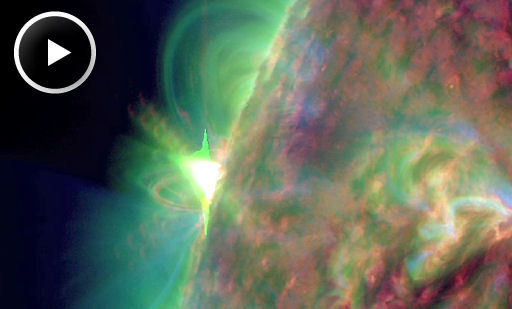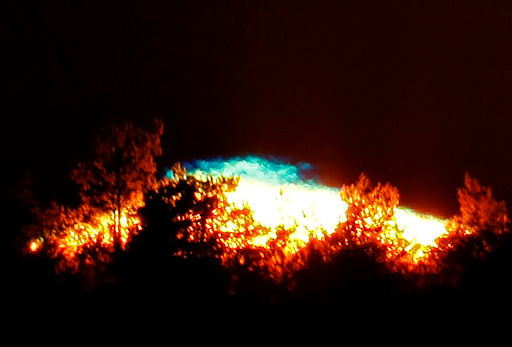FLYING THROUGH A GEOMAGNETIC STORM: Lately, the International Space Station has been flying through geomagnetic storms, giving astronauts a close-up view of the aurora borealis just outside their windows. ISS Flight Engineer Don Pettit shares the experience in a new video from Science@NASA.
EMERGING SUNSPOT, STRONG FLARE: A big new sunspot is emerging over the sun's northeastern limb. It announced itself on March 2nd at 1746 UT with an M3-class solar flare. NASA's Solar Dynamics Observatory recorded the extreme ultraviolet flash:
Although the blast site was partially eclipsed by the solar limb, the flare nevertheless created waves of ionization in Earth's upper atmosphere. Dave Gradwell of Birr Ireland detected the effect of these waves on the propagation of low-frequency radio signals across Europe. The explosion also hurled a faint CME over the northeastern limb: SOHO movie. The expanding cloud is not Earth-directed.
NOAA forecasters estimate a 55% chance of additional M-class flares and a 5% chance of an X-flare during the next 24 hours. Solar activity is picking up. Solar flare alerts: text, phone.
BLUE FLASH: We've all heard of the green flash, the fleeting emerald light that sometimes appears just above the setting sun. Once thought to be a fable, the green flash was popularized by Jules Verne in his 1882 novel "Le Rayon Vert" (The Green Ray). Now it is generally known to be real.
But what of the even rarer blue flash? Turns out, that's real too. Peter Rosén photographed one from Stockholm, Sweden, on Feb. 29th:
"I was shooting the sunset when, suddenly, just as the sun was about to disappear behind the treetops, there was a mighty blue flash," says Rosén.
Blues flashes are formed in the same way as green flashes: a mirage magnifies tiny differences in the atmospheric refraction of red, green and blue light. Blue flashes are generally harder to see than green flashes, because blue flashes blend into the surrounding blue sky. When the air is exceptionally clear, however, the blue flash emerges.
Verne described the green flash as something "which no artist could ever obtain on his palette, a green of which neither the varied tints of vegetation nor the shades of the most limpid sea could ever produce the like! If there is a green in Paradise, it cannot be but of this shade, which most surely is the true green of Hope."
Ditto the blue.

![]()
Solar wind
speed: 375.4 km/sec
density: 1.7 protons/cm3
explanation | more data
Updated: Today at 1626 UT
![]()
X-ray Solar Flares
6-hr max: B5 1003 UT Mar03
24-hr: C2 0609 UT Mar03
explanation | more data
Updated: Today at: 1600 UT
![]()
![]()
![]()
Daily Sun: 03 Mar 12
![]()
![]()
A large and active sunspot is emerging at the circled location. Credit: SDO/HMI
![]()
![]()
![]()
Sunspot number: 24
What is the sunspot number?
Updated 02 Mar 2012
Spotless Days
Current Stretch: 0 days
2012 total: 0 days (0%)
2011 total: 2 days (<1%)
2010 total: 51 days (14%)
2009 total: 260 days (71%)
Since 2004: 821 days
Typical Solar Min: 486 days
Updated 02 Mar 2012
The Radio Sun
10.7 cm flux: 108 sfu
explanation | more data
Updated 02 Mar 2012
![]()
![]()
![]()
Current Auroral Oval:
![]()
Switch to: Europe, USA, New Zealand, Antarctica
Credit: NOAA/POES
![]()
![]()
![]()
Planetary K-index
Now: Kp= 1 quiet
24-hr max: Kp= 3 quiet
explanation | more data
![]()
Interplanetary Mag. Field
Btotal: 5.5 nT
Bz: 2.1 nT south
explanation | more data
Updated: Today at 1627 UT
![]()
![]()
![]()
Coronal Holes: 02 Mar 12
![]()
![]()
A solar wind stream flowing from this minor coronal hole could reach Earth on March 5-6. Credit: SDO/AIA.






